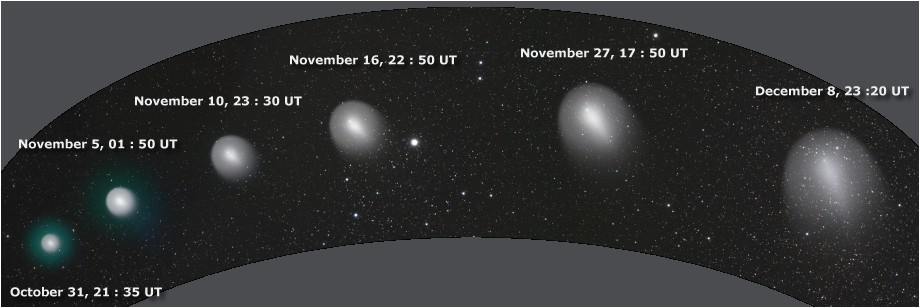
If anybody told me before October 24th 2007 that a comet weaker than 17th magnitude would be visible the next day with naked eyes, I would have only two explanations for that - a silly joke or a lovely fairytale. The Holmes comet managed it and it was not only visible with naked eyes but it nearly reached 2nd magnitude, i.e. it brightened about half million times in less than 24 hours. After that the comet brightness was fading only very slowly. One month after the outburst the comet was of about 3rd magnitude and still an easy naked eye object. Two month after the outburst (Christmas 2007) the brightness slightly decreased to about magnitude 3.5 and even if the comet became less contrast because of increasing size it was visible well without telescope. During January 2008 the comet was fading to about 4th magnitude and carried on fading very slowly. All the time the comet was in Perseus constellation (see this image).

The comet was discovered by Edwin Holmes on November 6, 1892 when it performed an outburst probably similar to the 2007 one. The comet was of magnitude 4 - 5 and faded from visibility over a period of several weeks. The calculated orbital period was about 6.9 years. The Holmes comet was observed again in 1899 and 1906 and after that it was lost for 58 years. It was rediscovered in 1964 and it has been observed on every return since. The comet behavior was without any significant surprise until October 23, 2007. Between October 23 and 24 the comet brightened from about magnitude 17 to nearly magnitude 2 in only several hours. This extreme outburst has no precedent (with possible exception - 1892 outburst of the same comet). The outburst took place in 2.43 AU distance from the Sun, 1.64 AU distance from the Earth and about half a year after comet's perihelion pass (May 4, 2007). As soon as I received the message about the Holmes comet astounding outburst, I tried to use the once-in-life chance to record this event. Unfortunately, the weather in central Europe is usually very bad in this period of year and year 2007 was no exception. Therefore, I decided to use a sort of desperate strategy which was finally more successful than I had expected. I used even the shortest periods of good observing conditions which often lasted several dozens of minutes. It was not possible to go by car far from the city in such a short time, it was even not enough time for precise polar alignment of my paralactic mount. Therefore, I took all images from the terrace of my house with short exposure times (mainly 30 second) without any mount guiding and only rough polar alignment. I compensated the drawbacks of this strategy by taking a large number of images which I composed in resulting image. This enabled me to obtain a rather numerous sequence of good images monitoring the Holmes comet evolution during November and December 2007. The comet position in the sky was optimal for observers on the northern hemisphere. The comet was near the zenith in our country at midnight. In January 2008, me and my wife were on a mountaineering expedition in Chile. Even though the comet was very low in the southern sky and my equipment was very limited, I took several images of Holmes comet in the Andes. Taking of these images was sometimes connected with interesting experience. After the return home I recorded the comet's encounter with California nebula in March 2008. I took the last image 134 days after the comet Holmes outburst. The comet was still of about magnitude 5.
Thanks to cooperation with my friends Arne Danielsen (Norway) and Dalibor Hanžl (Czech Republic) it was
possible to make the Holmes comet series more complete and to add some very good images.
Page versionfor slowInternet connection
Page versionfor slowInternet connection
Page versionfor slowInternet connection
Page versionfor slowInternet connection
Page versionfor slowInternet connection
Page versionfor slowInternet connection
Page versionfor slowInternet connection
Page versionfor slowInternet connection
Page versionfor slowInternet connection
Page versionfor slowInternet connection
Page versionfor slowInternet connection
Page versionfor slowInternet connection
Page versionfor slowInternet connection
Page versionfor slowInternet connection
Page versionfor slowInternet connection
Page versionfor slowInternet connection
Page versionfor slowInternet connection
Page versionfor slowInternet connection
Page versionfor slowInternet connection
Page versionfor slowInternet connection
Page versionfor slowInternet connection
Page versionfor slowInternet connection
Page versionfor slowInternet connection
Page versionfor slowInternet connection
Page versionfor slowInternet connection
Page versionfor slowInternet connection
Page versionfor slowInternet connection
Page versionfor slowInternet connection
Page versionfor slowInternet connection
Page versionfor slowInternet connection
Page versionfor slowInternet connection
Page versionfor slowInternet connection
Page versionfor slowInternet connection
Page versionfor slowInternet connection
Page versionfor slowInternet connection
Page versionfor slowInternet connection
Note: If any page needs more than 100 KB to be downloaded, there exists its lower quality version appointed for slow connection.
Page last update: 3.2.2010 |